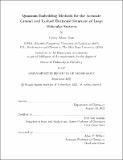Quantum Embedding Methods for the Accurate Ground and Excited Electronic Structure of Large Molecular Systems
Author(s)
Tran, Henry Khoa
DownloadThesis PDF (62.49Mb)
Advisor
Van Voorhis, Troy
Terms of use
Metadata
Show full item recordAbstract
The class of quantum embedding methods has shown great promise in achieving high accuracy simulations of large molecular and material systems by dividing the system into smaller fragments. However, some of their successes are limited to model systems and molecules in minimal basis sets, including methods based on the Schmidt Decomposition such as density matrix embedding theory (DMET) and bootstrap embedding (BE).
Understanding photochemistry and reaction mechanisms requires simulations of excited states. We used DMET to target excited states for the first time, accurately calculating the first excited state in a variety of systems. We then adapted BE to start from an unrestricted bath, which better models excited states. From this, BE could predict IEs, EAs, and singlet-triplet gaps with accuracy on par with popular quantum chemical methods. Both of these successes allowed us to study the band gaps of graphene quantum dots and organic polymers where BE converges to within 0.1 eV of the desired quantum chemical method.
None of these calculations can truly model real systems if they are performed in minimal basis sets. The theory behind BE is adapted for extended basis sets through the use of careful orbital localization, utilizing intrinsic atomic orbitals. The BE matching condition is restricted to well-localized orbitals, which allows BE to converged to at least 99\% of the correlation energy in basis sets up to cc-pVDZ. For the troublesome cases involving more diffuse and polarization effects, pair natural orbitals (PNOs) were reformulated for the embedding framework and BE with PNOs, PNO-BE, demonstrated a faster convergence to the correct correlation energy than simply increasing the fragment size. PNO-BE captures over 99\% of the correlation in systems where electronic effects are expected to span multiple atoms and provides an alternative to improving BE without letting the fragment size blow up exponentially.
Date issued
2022-09Department
Massachusetts Institute of Technology. Department of ChemistryPublisher
Massachusetts Institute of Technology